Don’t let limited space stop you from creating a wonderful garden!
Even small patios, balconies, or yards can become mighty retreats with clever ideas.
Treat your small space like decorating a room: first, decide its purpose.
Is it for morning coffee, growing herbs, displaying flowers, or simply relaxing? Focus on what makes you happy.
Our gathered ideas, from raised beds to repurposed planters, offer easy and affordable ways to create an outdoor space you’ll truly enjoy spending time in.
Rustic Boho Balcony with Warm Accents

A cozy balcony blends rustic charm with bohemian vibes, featuring wicker chairs, a pallet coffee table, and an array of potted plants.
Vibrant flowers and string lights add a cheerful, welcoming glow, while patterned cushions and rugs create a sense of warmth and personality.
This charming space invites relaxation and is perfect for unwinding with a book or hosting friends.
Add Definition with a Pergola
:strip_icc():format(webp)/outdoor-seating-area-under-pergola-5oxJbnxB4ngBpfPwrJVbwq-e3a4e5a44cc6403486cd4d2c6e5d4c71.jpg)
Turn a tiny patio into a gorgeous outdoor room with a freestanding pergola.
Here, a small wooden pergola stands over a gravel patio.
The landscaping fixture creates a sense of enclosure and makes the patio seem much larger than it is, and a teak seating arrangement compliments the warm-stained millwork.
Go Gravel
:strip_icc():format(webp)/patio-made-sand-sitting-area-DTmIr51IqH_AQOIJCehy1i-a6b21e7093684c869d1fef652c153bf4.jpg)
Small garden ideas don’t have to be expensive and difficult to execute.
For example, crushed brick or gravel is a beautiful, low-maintenance paving option for smaller yards.
It’s easier to use and less expensive than brick pavers or flagstones.
In outdoor spaces like this one, the gravel allows rainfall to percolate through to the soil instead of running off down a hill.
Spread a layer of landscape fabric underneath the gravel to keep weeds from popping through.
Get Creative with Barren Land
:strip_icc():format(webp)/outdoor-metal-tables-chairs-7pQgBtmcKAh8fMZRR3djGw-4663fa5760c245fa9662acabd98032ae.jpg)
If you have large trees with barren ground at their bases, why not put the infertile land to use in a way that doesn’t involve a garden bed?
In this small yard, several trees made growing grass or a flowerbed impossible.
Instead, the homeowners paved the area with flagstone and added a table and chairs for shaded seating.
When working under a large tree, leave any exposed roots alone and never raise the grade around the tree’s base.
Install a Pond
:strip_icc():format(webp)/pond-rocks-lily-pads-2R_zkgpaqmk8ULGbn-5SZ5-45e9341f8e0d4d069cfc66000096ade1.jpg)
You don’t need a huge backyard to have a water garden.
In fact, installing a water garden is a great way to handle low or wet spots in your yard. Dig out the area, add a pond liner and pump, and you’re on your way.
Even a tiny oasis with a garden fountain will attract colorful butterflies and birds.
Incorporate Trellises for Vertical Gardens
:strip_icc():format(webp)/plants-growing-on-wood-on-side-brick-house-D_o3cvKzavjBl6-Qi8EKfy-5c762b6c33db45688d0e42ec84830306.jpg)
One of the best small garden ideas for maximizing flowers and vegetables is incorporating trellises behind every planting bed.
This allows you to grow vine crops vertically so they won’t sprawl over their plant neighbors.
This narrow plot, for example, uses a trio of rustic wooden trellises to support flowering vines at the back of the perennial border.
Trade Grass for Pea Gravel
:strip_icc():format(webp)/table-chairs-on-patio-DtGkA8Hy4LcBZHvHiXyYHV-1484c757b7454ec6b64f9a1d2b975f0a.jpg)
Put every square inch of your backyard to work by swapping sod for landscaping pebbles.
In this small courtyard, the turf was torn up and replaced by a gravel base that supports a gorgeous dining table and flower-filled containers.
This is one of the best small garden ideas for homeowners who are averse to mowing.
This backyard update eliminates the landscaping chore in favor of more time to sit back and enjoy the outdoor space.
Romanticize with an Arbor
:strip_icc():format(webp)/brick-patio-white-pergola-DW6UI6lHKb19hKyav7uw8h-1e8edcfbef454c92b4e26d1be059057e.jpg)
Add charming flair to a small yard by featuring an arbor as a focal point.
The ornamental fixture will capture the eye and give the impression of a larger yard while lending the landscape a dreamy feel.
Here, a grand entry arbor supports a crown of climbing roses for a romantic, intimate landscape.
White lilies in the center bed mirror the white roses and arbor for a cohesive look.
Use Terra-Cotta Pots
 Jane Merritt/The House That Lars Built
Jane Merritt/The House That Lars Built
Display multi-colored flowers in a tiered terra-cotta planter to save ground space.
Take it a step further by recreating the beauty of a rainbow, using red tulips, orange tiger lilies, yellow daffodils and so on.
Craft a Sun Catcher
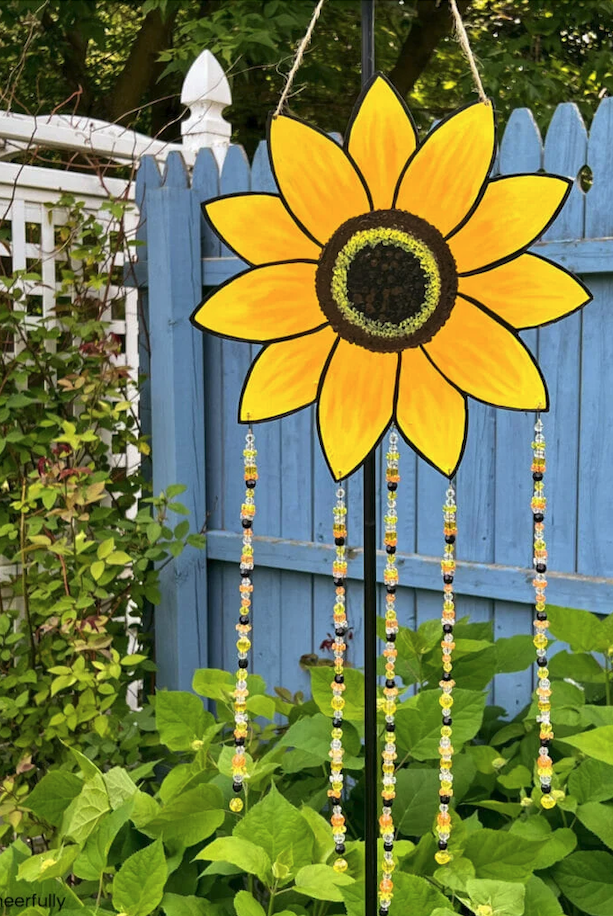 Crafting Cheerfully
Crafting Cheerfully
This hand-crafted sunflower sun catcher will add a dose of cheer to your outdoor garden.
You’ll need a wooden flower and acrylic paint to get started, plus beads that’ll sparkle in full sun.
Make a Wheelbarrow Garden
 Sergio Amiti//Getty Images
Sergio Amiti//Getty Images
Turn an old wheelbarrow into a rustic flower garden. Just drill a few holes in the bottom for drainage.
What’s great about this setup is you can relocate your garden as needed.
Repurpose Vinyl Gutters
 Pretty in the Pines
Pretty in the Pines
If you’re short on backyard space, hang flower-filled planters from the porch.
White vinyl gutter and about 20 feet of nylon rope are the main components of this adorable hanging garden.
Use Plant Supports

Tilly Design
Help your crops grow taller and straighter with metal support stakes.
Keep your plants off the ground and give them better access to sunlight, while also adding visual interest to your small garden.
Incorporate a Small Pond
 dolah//Getty Images
dolah//Getty Images
Dedicate space for a small fish pond surrounded by natural paving stones, then fill in the area with lush bushes and flowers.
You’ll likely want to start with a pond liner, but keep in mind you’ll need an array of items to keep fish alive (like a pond pump and filter).
Choose a Sunny Setup
 Kody kohlman for Tilly
Kody kohlman for Tilly
Before building a garden, keep in mind that most vegetables and fruits prefer full sun (at least six hours of sun per day).
Here, Tilly Design carefully considers the needs of each plant and chooses to use a mix of raised garden beds and planting directly into the ground.
Grow a Cocktail Garden
 Helen Norman
Helen Norman
You guessed it!
A cocktail garden is a space designated to growing ingredients for delicious drinks.
Go for herbs like mint, basil and sage, as well as fruits and veggies such as strawberries, cherries and peppers.
Set Up a Gardening Station
 Buff Strickland
Buff Strickland
Create a spot dedicated to potting and trimming your outdoor plants. The best part?
This table is made from a few galvanized barrels and an old wooden door.
Build a Pallet Garden

Elke Borkowski; GAP Photos/El
Attach clay pots to a pallet with nails and stainless steel cable ties for a living art display that keeps your rosemary and basil at the ready.
Space out the pots so your plants have room to grow.
Use Containers to Create a “Garden”
:max_bytes(150000):strip_icc():format(webp)/3-GettyImages-173233972_edited-1-57f67de83df78c690f36c97e.jpg) Kerstin Waurick / Getty Images
Kerstin Waurick / Getty Images
A group of planters can delineate a small “garden,” even without grass or yard space.
Whether you are trying to create a sense of privacy or encourage neighbors to stop by and chat, a simple table and chairs encircled with large containers turns this open space into a joyful bistro-like gathering spot.
Play With Vertical Garden Space
:max_bytes(150000):strip_icc():format(webp)/5-GettyImages-122001114_edited-1-57f67bf35f9b586c35065adc.jpg) Neil Holmes / Getty Images
Neil Holmes / Getty Images
By training vines along the wall of the house and the adjoining fence, an intimate, yet opulent, dining space is created.
This is especially useful if the only space you have to garden in is a tiny courtyard.
The small pond in the foreground adds a cottage garden feel, with moss growing on the stone and wide clumps of flowering plants.
Try Out Trellises
:max_bytes(150000):strip_icc():format(webp)/30-GettyImages-128135477_edited-1-57f6813a3df78c690f379555.jpg) Claire Higgins / Getty Images
Claire Higgins / Getty Images
Growing a tree along a trellis is a great way to reap the benefits and save space.
The only thing more amazing than how much fruit you can get from one espaliered tree is how attractive and tempting it looks spread out on a patio fence or wall.
While it looks very complicated and exacting, all it takes to grow a trellised fruit tree is some hooks, wire, and patience.
In a few years, you’ll have an orchard within arms reach. Apples, pears, peaches, plums, even persimmons can all be trained to grow this way.
Try DIY Raised Garden Beds
Using DIY raised garden beds adds rustic charm to this cottage garden from Liz Marie Blog that is surrounded by a vinyl picket garden fence.
Depending on your materials, this could be an extremely budget-friendly option to add structure to a small yard or garden.
Add a Ladder
:max_bytes(150000):strip_icc():format(webp)/GettyImages-130795057-9c3b4a66ce4148128512d260852fd7e7.jpg) Anne Green-Armytage / Getty Images
Anne Green-Armytage / Getty Images
Using a ladder as a functional trellis or storage solution for potted plants and herbs makes it easy to add a curtain of greenery to a wall, whether you choose a rustic ladder with well-worn character or paint it a bright, cheerful color.
Ladders are often used to hold things indoors and are just as functional and attractive outside.
Incorporate Luxury Garden Furniture
:max_bytes(150000):strip_icc():format(webp)/6-GettyImages-157611714_edited-1-57f67e5f3df78c690f37181a.jpg) Eirasophie / Getty Images
Eirasophie / Getty Images
Add grandeur to your small garden by choosing high-end furnishings.
Rather than a standard deck with an umbrella table and grill, this space incorporates a water garden filled with lush, low-maintenance plants, such as hostas, ornamental grasses, water lilies, and a flowering clematis vine, for color.
The sound of trickling water can be enjoyed in over-sized, comfy chairs that offer a respite from the afternoon sun with an over-sized arbor and bamboo shades.
Capitalize on Trees
:max_bytes(150000):strip_icc():format(webp)/7-GettyImages-182173697_edited-1-57f67ec65f9b586c350a8113.jpg) YinYang / Getty Images
YinYang / Getty Images
If you are lucky enough to have a shade tree in your yard, put it to good use and create a seating area nearby.
The spiraling pattern of the borders makes the space seem larger.
Raised beds nearby provide extra seating or table space and make the garden easier to maintain.
Add Lights for Evening Sparkle
:max_bytes(150000):strip_icc():format(webp)/26-GettyImages-607833303_edited-1-57f680a03df78c690f3740a4.jpg) Joseph Esquivel / Eyeem / Getty Images
Joseph Esquivel / Eyeem / Getty Images
Adding hanging lights will create a magical feeling in your small garden come evening.
You can string the trees with fairy lights or create your own, personalized lanterns.
A rope attached to the lids of canning jars filled with candles or LED lights does the trick here.
Make it even more magical by including some fragrant flowers, to take over as the flowers take a backseat in the dark.
Beckon With Blooms
:max_bytes(150000):strip_icc():format(webp)/92-GettyImages-179182400_edited-1-57fe234f3df78c690f83f29f.jpg) Chris Mellor / Getty Images
Chris Mellor / Getty Images
Using plants to lead guests into your garden or home feels joyful and welcoming.
Vines and shrubs are also a great option, but when your entryway is entirely paved, containers are the way to go.
Don’t go small on impact. Either choose a large container and fill it to overflowing with plants or use smaller pots and lots of them.
These geraniums and impatiens make a joyful greeting without getting in the way of anyone going up the steps.
Annual plants are great choices because they will remain in bloom all season.
Plant Potted Fruit Trees
:max_bytes(150000):strip_icc():format(webp)/32-GettyImages-103631036_edited-1-57f6c9555f9b586c35686f86.jpg) Paul Taylor / Getty Images
Paul Taylor / Getty Images
Planting small trees in containers is a great way to frame a garden space (just about anything that can be grown in the ground can be grown in a container).
If you spend the bulk of your outdoor time on your deck or patio, bring some appetizing plants right near your table.
Dwarf citrus trees are perfect candidates for patio containers.
They don’t need an overly large pot and remain small enough to move about if you need to.
Although they cannot withstand freezing winters, citrus trees can be brought indoors to enjoy as houseplants until you and your tree are ready to revel in summer sunshine again.
Play With Garden Proportion
:max_bytes(150000):strip_icc():format(webp)/House-Tours_136_edited-1-57ff58e23df78cbc2809f69e.jpg) Marie IannottiLarger shrubs keep the proportion of a more traditional foundation planting and also reduce the amount of maintenance you will have to do.
Marie IannottiLarger shrubs keep the proportion of a more traditional foundation planting and also reduce the amount of maintenance you will have to do.
And using this combination will help set your house apart with some unexpected curb appeal.
That is something important to keep in mind if you live on a busy road.
Make sure you can still see out your windows but have fun tucking in small surprises of color and texture or scent.
Incorporate a Garden Birdfeeder
:max_bytes(150000):strip_icc():format(webp)/102-GettyImages-668815967_edited-1-57ffd9cc5f9b5805c2ae541d.jpg) Mark Rainwater / EyeEm / Getty Images
Mark Rainwater / EyeEm / Getty Images
Adding a bird feeder is a charming garden ornament option all year, especially in winter, when it attracts a flurry of hungry birds.
Some wildlife is welcome in the garden and birds would have to be at the top of the list.
They’ll add color, sound, and movement when your yard needs it most.
Have an Herb Garden
:max_bytes(150000):strip_icc():format(webp)/108-GettyImages-121779317_edited-1-57ffd2863df78cbc288da1e1.jpg) Maximilian Stock Ltd. / Getty Images
Maximilian Stock Ltd. / Getty Images
Not only are potted herbs space savers, but making them the focal point of your small garden also serves a culinary purpose.
Herbs are among the easiest edible plants to grow and they require very little room in their planters.
You could even keep a pot on your table, for the freshest flavor possible.
Top Off the Railings
:max_bytes(150000):strip_icc():format(webp)/109-GettyImages-182422180-57ffe2ce5f9b5805c2b04f0e.jpg) kevin miller / Getty Images
kevin miller / Getty Images
Dress up the top of your deck’s railings with flower boxes contoured to fit snuggly over the rail.
They add color to the deck, without taking up floor space. They even give a little extra privacy.
Create a Container Garden
:max_bytes(150000):strip_icc():format(webp)/House-Tours_104_edited-1-57ff5e945f9b5805c2245402.jpg) Marie IannottiCreating a container garden is the easiest way to add plants and color to a small space.
Marie IannottiCreating a container garden is the easiest way to add plants and color to a small space.
Mix up the sizes of the planting containers and also the plants, for a true garden feel.
Maintaining a color palette within either the plants or the containers themselves will tie the space together and make it feel like a real garden.
Make a Succulent Tapestry
:max_bytes(150000):strip_icc():format(webp)/43-GettyImages-123533355_edited-1-57f6cbb53df78c690f77728d.jpg) Mark Turner / Getty Images
Mark Turner / Getty Images
If you don’t have the interest or the time to devote to a flowering garden, using succulent plants in your small garden is the answer for you.
These fleshy-leaved plants virtually never need to be watered and there’s no need to prune or deadhead, either.
Many will happily spread and flow into one another, creating a tapestry carpet that smothers out weeds.
Even if they don’t have spectacular flowers, the leaves can be colorful enough on their own. And many survive for years on neglect.
Blooming Backyard Nook with Subtle Storage

A cozy garden nook bursts with life through vibrant flowers and lush potted plants.
A small café table and chair in soft pastel tones provide a quaint setting for a morning coffee.
Cleverly integrated storage beneath a wooden bench ensures functionality, while climbing flowers add vertical beauty, creating a balance of practicality and charm in this compact outdoor haven.
Narrow Courtyard Filled with Rustic Charm

A narrow courtyard becomes a lush retreat with an abundance of potted herbs and flowers.
Vibrant nasturtiums line the garden bed, while rustic wooden shelves showcase potted greenery.
A small bistro table invites conversation, surrounded by earthy tones and intricate lanterns.
The use of vertical gardening maximizes the space, proving that even small patios can exude character and warmth.
Intimate Garden Escape with Pergola

This small garden is a serene escape with a wooden pergola draped in twinkling string lights and climbing plants.
A wooden bench framed by boxwood hedges and vibrant blooms adds a cozy, private seating area.
Soft green tones and delicate floral accents create an enchanting retreat, blending natural elements with thoughtful design.
Vibrant Pathway Garden with Splashes of Color
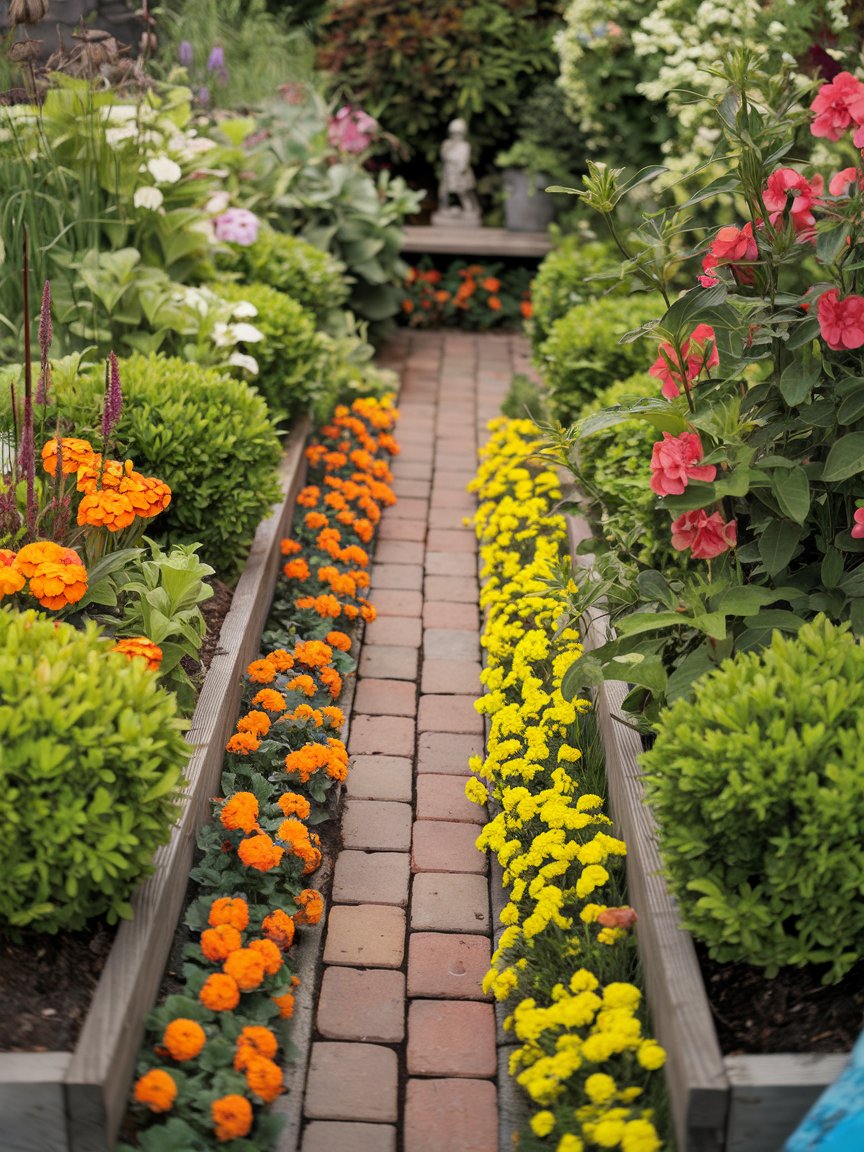
A beautifully designed pathway flanked by raised flower beds creates a feast for the eyes.
Bright marigolds, lush greenery, and colorful blooms form a cheerful border, while a red-brick path adds rustic elegance.
This compact, linear design highlights how careful layering and color coordination can elevate a small garden into a stunning display.
Urban Balcony Herb Garden

This urban balcony is transformed into a practical herb garden with creative vertical shelving and hanging planters.
Wooden crates and metal containers house fragrant basil, thyme, and other fresh greens, maximizing the small space.
A simple café set in green tones blends seamlessly into the design, making this space a functional and stylish spot for gardening enthusiasts.
Cozy Outdoor Cinema with Natural Accents

This charming backyard cinema combines comfort and nature with bean bags, pillows, and soft lighting.
Surrounded by lush greenery and rustic wooden panels, the outdoor screen offers an inviting space for movie nights.
Lanterns and string lights enhance the magical atmosphere, proving that even small backyards can double as an entertainment hub.
Modern Pergola with Layered Greenery

A stylish pergola enhances this compact patio, surrounded by tall ornamental grasses and vertical planters.
A cozy sectional sofa with neutral cushions offers a relaxing spot, while a bistro table adds functionality for casual dining.
The layered greenery and muted tones create a calm, contemporary ambiance, blending privacy with comfort.
Elegant Courtyard Lounge with Natural Touches

This intimate lounge area under a pergola features a soft sofa framed by greenery and string lights.
Potted lavender, ivy, and stone textures add an earthy charm, while the warm lighting creates a cozy and romantic setting.
The simple layout showcases the beauty of a small courtyard transformed with minimal effort.
Raised Garden Beds with Farmhouse Appeal

A backyard brimming with functionality and charm showcases raised garden beds arranged around a central dining table.
The wooden planters, filled with fresh vegetables and herbs, make gardening accessible and stylish.
String lights illuminate the area, blending farmhouse aesthetics with modern outdoor living, perfect for gatherings and fresh farm-to-table meals.
Modern Fire Pit with Desert Garden Style
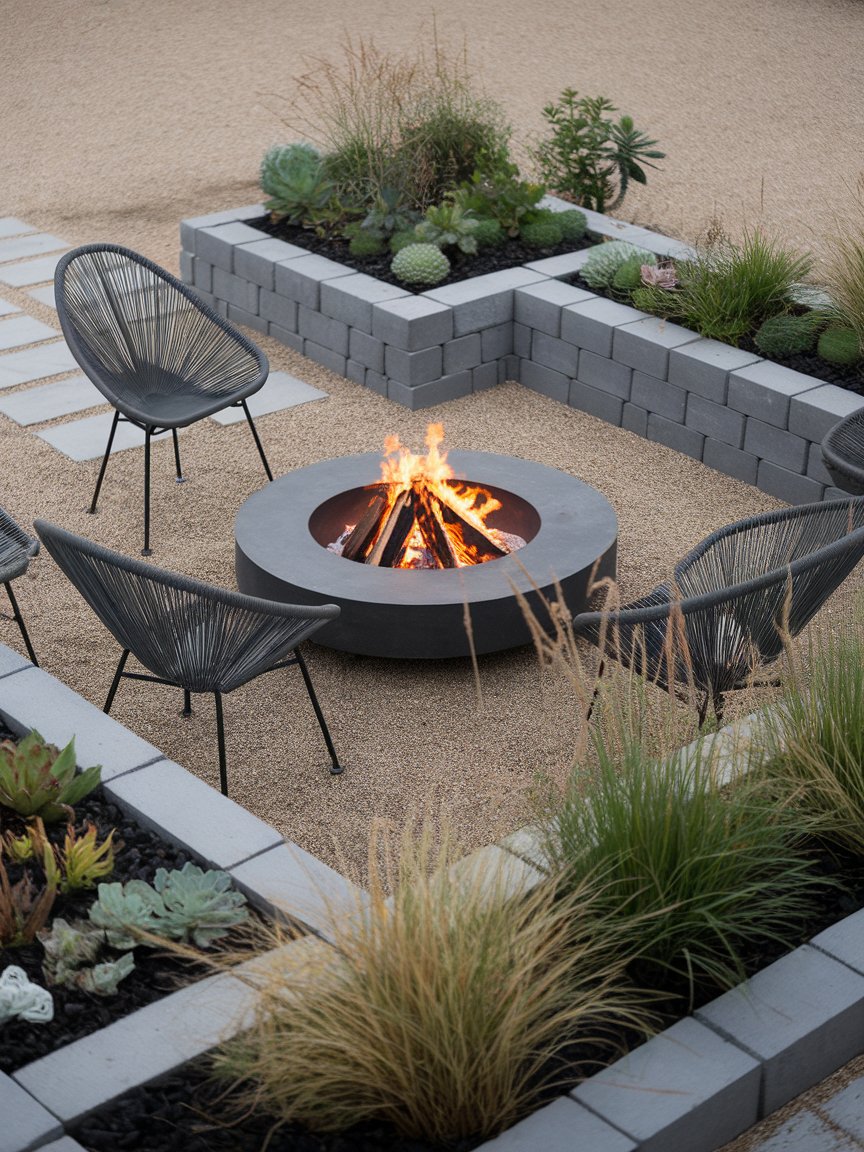
This contemporary fire pit area creates an inviting space with a sleek circular design surrounded by gravel and succulents.
Raised garden beds with drought-tolerant plants like grasses and cacti add texture and sophistication.
Black wire-frame chairs complement the minimalistic aesthetic, making it a perfect spot for cozy evenings under the stars.
Rustic Covered Patio with Boho Accents
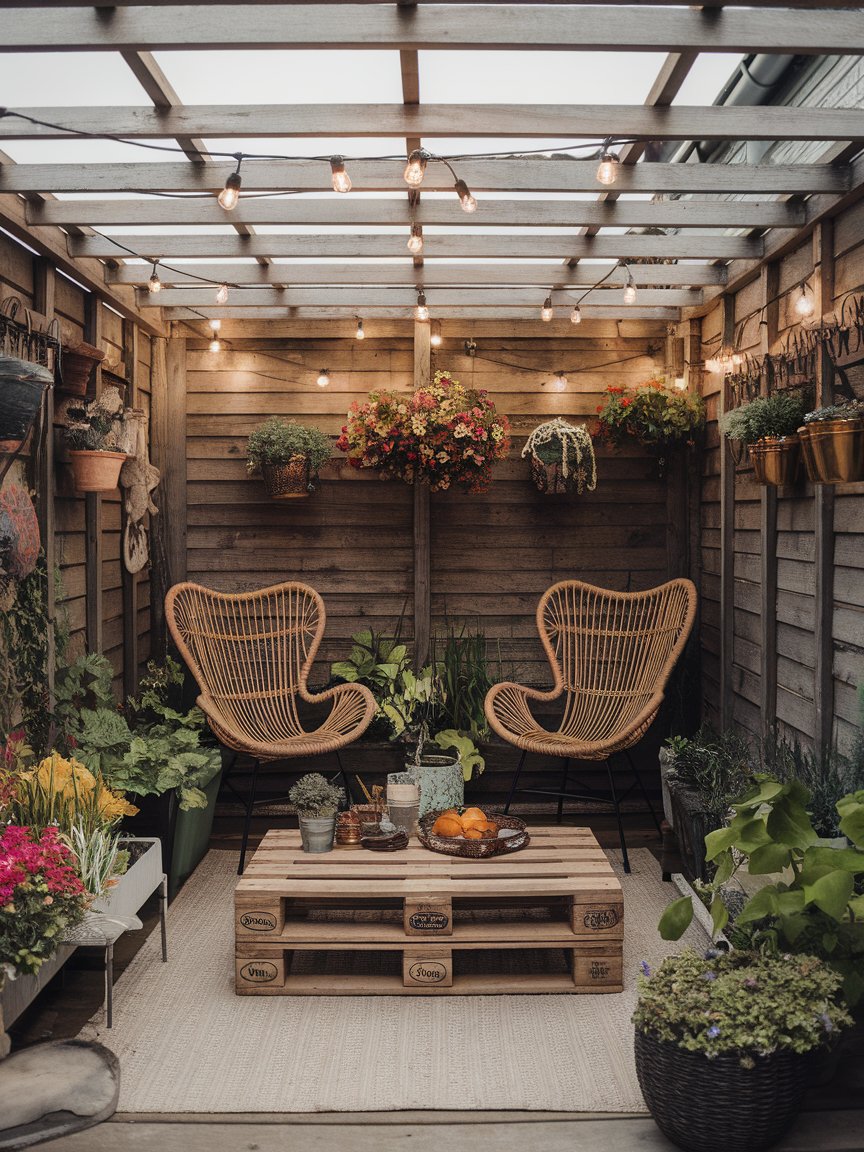
A rustic patio combines functionality and charm with rattan chairs and a pallet coffee table.
Hanging planters overflowing with flowers add vibrant color, while string lights create a warm and welcoming glow.
Surrounded by wood tones and lush greenery, this space is a perfect blend of boho and rustic styles for an intimate gathering spot.
Cozy Corner Deck with Built-In Bench

A small corner deck is transformed into a charming retreat with a built-in wooden bench adorned with cozy pillows.
A bistro table adds functionality, while surrounding potted plants and hanging shelves provide a touch of greenery.
This compact yet thoughtfully designed setup invites relaxation and dining in a peaceful outdoor setting.
Vibrant Patio Lounge with Pallet Seating

This colorful patio exudes playful charm with upcycled pallet seating and bright turquoise cushions.
String lights and climbing greenery enhance the cozy atmosphere, while a reclaimed barrel coffee table adds rustic appeal.
The bold mix of colors and textures makes this a standout space for casual lounging or entertaining guests.
Vertical Garden in a Quaint Courtyard

A narrow courtyard is brought to life with vertical gardening on trellises and walls. Colorful blooms line the raised bed, while herbs and potted plants complete the lush environment.
A small café set provides a cozy seating area, surrounded by greenery that maximizes space while maintaining a relaxing vibe.
Simple Garden Path with Pergola Accent

This minimalist backyard combines elegance with simplicity, featuring a clean stone path leading to a classic wooden bench under a pergola.
Bright flower beds flank the path, adding pops of color that contrast beautifully with the lush green lawn.
The arrangement creates a serene atmosphere perfect for relaxation and contemplation.
Flower-Filled Garden Path with a Sunflower Backdrop

A long garden path bursts with vibrant color, lined with marigolds, zinnias, and lush greenery.
Tall sunflowers frame the focal point—a graceful birdbath—set against a backdrop of trees.
The bold layout showcases a perfect mix of wild beauty and careful design, ideal for enjoying nature up close.
Narrow Brick Walkway with Cottage Charm

This cheerful garden features a red-brick walkway flanked by bold red, yellow, and orange blooms.
Boxwood hedges and tall greenery create structure, while a small bench nestled at the end of the path offers a cozy place to relax.
The blend of bright colors and soft greenery makes this compact space feel vibrant and welcoming.
Balcony Vegetable Garden with Vertical Shelves

An urban balcony comes alive with a practical vegetable garden featuring vertical shelving and wooden crates.
Lush greens like lettuce and basil are complemented by hanging planters, making the most of the small space.
A bistro set adds charm, offering a cozy spot to enjoy the fruits of this sustainable garden.
Contemporary Water Feature with Lavenders

This sleek backyard design centers around a rectangular water feature surrounded by aromatic lavender and ornamental grasses.
The clean lines of the feature blend with natural greenery for a peaceful, modern aesthetic.
Adjacent to a stylish patio, this space offers a relaxing retreat with a perfect mix of hardscape and softscape elements.
Create a Living Wall
 Stephen Karlisch
Stephen Karlisch
If you don’t have floor space to display your plants, mount pots onto the exterior of your house.
Here, interior designer Tori Rubinson sticks with terra-cotta pots, but you can also go for bold patterns and colors!
Embrace Container Gardening
 Buff Strickland
Buff Strickland
Green up your patio or deck with oversized terra-cotta or plastic planters overflowing with anything from tomatoes to wildflowers. (The lush lineup here creates a pretty privacy wall!)
Opt for a Vertical Herb Garden
 A Beautiful Mess
A Beautiful Mess
Whether you have a small yard or lack outdoor space altogether, a vertical garden can be a charming addition.
You can create one on your own with landscape fabric and copper pipe.
Try Square-Foot Gardening
 Arterra//Getty Images
Arterra//Getty Images
This highly efficient method divides raised beds into a grid.
Vegetables then get planted in one or more squares at a density based on plant size (e.g., you’d plant about 16 radish seeds per square, but only one tomato plant).
DIY a Bubble Fountain
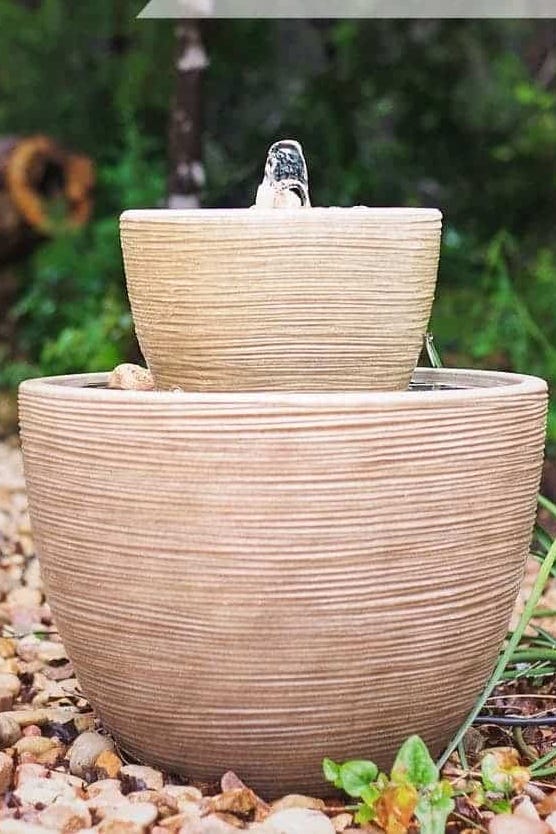 Scared Thoughts of a Crafty Mom
Scared Thoughts of a Crafty Mom
With just a few supplies, including a submersible pump, a waterproof pot and decorative river rocks, you can make your garden more zen with an eye-catching DIY bubble fountain.
Put Up a Vertical Planter
 Angela Marie Made
Angela Marie Made
Not only does this DIY take up less surface area than multiple pots on the ground would, but it can also serve as a privacy fence for nosy neighbors.
Assemble an Herb Garden
 A Beautiful Mess
A Beautiful Mess
There’s something special about an orderly display of potted plants, especially when they’re in vibrant colors that showcase the beauty of the season.
Upcycle an Old Ladder
 Courtesy of DK Publishing
Courtesy of DK Publishing
Turn a wooden ladder into a space-saving stand for flowers, veggies and herbs with just a few boards and a coat of paint.
Repurposed Garden Gutters
 martinwimmer//Getty Images
martinwimmer//Getty Images
Both functional and eco-friendly, repurposed gutters offer a sustainable way to breathe life into unused items while adding charm and greenery to any small garden.
They’re great for urban gardeners looking to innovate with limited space.
Assemble an Arched Trellis
 KenWiedemann//Getty Images
KenWiedemann//Getty Images
Bring on the timeless charm!
An arched trellis creates a striking focal point while supporting climbing plants like roses, ivy, or morning glories.
Use it as an entryway or a dividing feature to define different garden areas, making your space feel larger and more structured.
Start a Gardening Station
 Westend61//Getty Images
Westend61//Getty Images
Creating a compact gardening station will help to keep your garden tidy by providing storage for tools, pots, and soil in one accessible spot.
Use a simple table, repurposed cabinet, or even a wall-mounted solution with hooks and shelves to conserve space.



:max_bytes(150000):strip_icc():format(webp)/Liz-Marie-Garden-Updates-2-2048x1536-b179d21aaeed4fff8a336aa3919067a7.jpg)